

Redis 源码解析之通用双向链表(adlist) - 杨领well
source link: https://www.cnblogs.com/yanglingwell/p/17297650.html
Go to the source link to view the article. You can view the picture content, updated content and better typesetting reading experience. If the link is broken, please click the button below to view the snapshot at that time.

Redis 源码解析之通用双向链表(adlist)
Redis源码中广泛使用 adlist(A generic doubly linked list),作为一种通用的双向链表,用于简单的数据集合操作。adlist提供了基本的增删改查能力,并支持用户自定义深拷贝、释放和匹配操作来维护数据集合中的泛化数据 value。
adlist 的数据结构
- 链表节点
listNode, 作为双向链表,prev,next指针分别指向前序和后序节点。void*指针类型的value用于存放泛化的数据类型(如果数据类型的 size 小于sizeof(void*), 则可直接存放在value中。 否则value存放指向该泛化类型的指针)。
// in adlist.h
typedef struct listNode {
struct listNode *prev;
struct listNode *next;
void *value;
} listNode;
- 链表迭代器
listIter, 其中next指针指向下一次访问的链表节点。direction标识当前迭代器的方向是AL_START_HEAD(从头到尾遍历)还是AL_START_TAIL(从尾到头遍历)。
// in adlist.h
typedef struct listIter {
listNode *next;
int direction;
} listIter;
/* Directions for iterators */
#define AL_START_HEAD 0
#define AL_START_TAIL 1
- 双向链表结构
list。 其中,head和tail指针分别指向链表的首节点和尾节点。len记录当前链表的长度。函数指针dup,free和match分别代表业务注册的对泛化类型value进行深拷贝,释放和匹配操作的函数。(如果没有注册dup, 则默认进行浅拷贝。 如果没有注册free, 则不对value进行释放。如果没有注册match则直接比较value的字面值)
// in adlist.h
typedef struct list {
listNode *head;
listNode *tail;
void *(*dup)(void *ptr);
void (*free)(void *ptr);
int (*match)(void *ptr, void *key);
unsigned long len;
} list;
adlist 的基本操作
- 创建:
listCreate初始化相关字段为零值。可以通过listSetDupMethod,listSetFreeMethod,listSetMatchMethod来注册该链表泛化类型value的dup,free和match函数。
/* Create a new list. The created list can be freed with
* listRelease(), but private value of every node need to be freed
* by the user before to call listRelease(), or by setting a free method using
* listSetFreeMethod.
*
* On error, NULL is returned. Otherwise the pointer to the new list. */
list *listCreate(void)
{
struct list *list;
if ((list = zmalloc(sizeof(*list))) == NULL)
return NULL;
list->head = list->tail = NULL;
list->len = 0;
list->dup = NULL;
list->free = NULL;
list->match = NULL;
return list;
}
#define listSetDupMethod(l,m) ((l)->dup = (m))
#define listSetFreeMethod(l,m) ((l)->free = (m))
#define listSetMatchMethod(l,m) ((l)->match = (m))
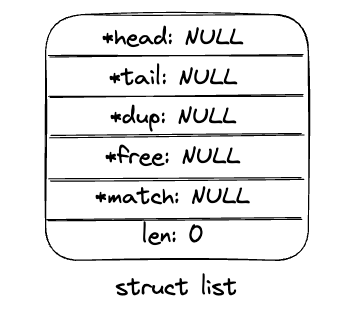
- 在链表首插入新节点:
listAddNodeHead
-
在空链表插入新节点: 为
value创建新节点,并让list的head和tail都指向新节点。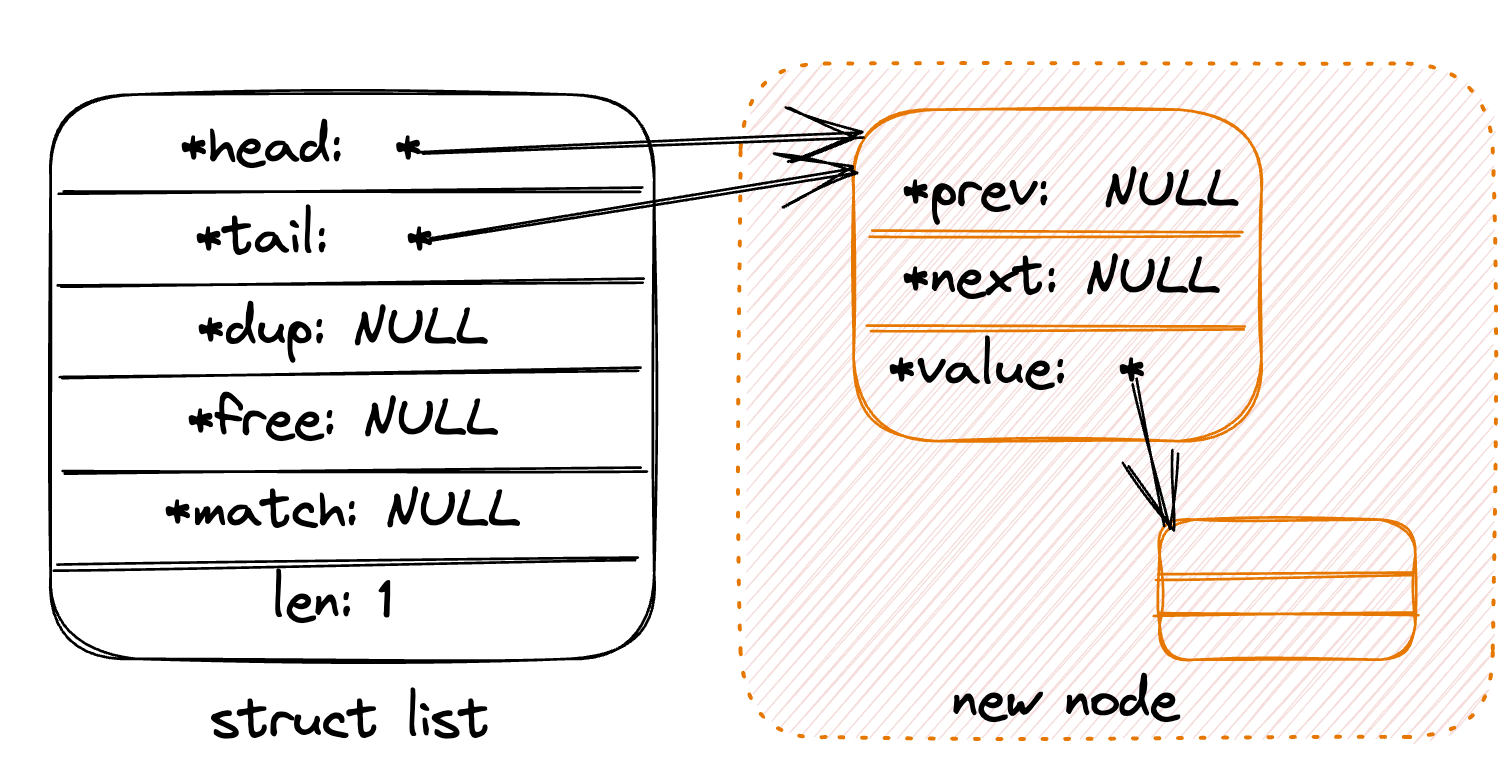
-
在非空链表插入新节点:
(1) 将新节点的next指向当前首节点(当前首节点将成为第二节点, 将会是新节点的后继节点)
(2) 将当前节点的prev指向新节点, 新节点作为新的首节点将成为原首节点的前驱节点。
(3) 将head从原本指向旧的首节点改为指向新节点, 将新节点作为链表首。
(4) 链表总计数加一
/* Add a new node to the list, to head, containing the specified 'value'
* pointer as value.
*
* On error, NULL is returned and no operation is performed (i.e. the
* list remains unaltered).
* On success the 'list' pointer you pass to the function is returned. */
list *listAddNodeHead(list *list, void *value)
{
listNode *node;
if ((node = zmalloc(sizeof(*node))) == NULL)
return NULL;
node->value = value;
listLinkNodeHead(list, node);
return list;
}
/*
* Add a node that has already been allocated to the head of list
*/
void listLinkNodeHead(list* list, listNode *node) {
if (list->len == 0) {
list->head = list->tail = node;
node->prev = node->next = NULL;
} else {
node->prev = NULL;
node->next = list->head;
list->head->prev = node;
list->head = node;
}
list->len++;
}
- 在链表尾插入新节点:
listAddNodeTail
- 在空链表插入新节点: 逻辑与
listAddNodeHead实现一致。 - 在非空链表插入新节点:
(1) 将新节点的prev指向当前首节点(当前尾节点将成为倒数第二节点, 将会是新节点的前驱节点)
(2) 将当前节点的next指向新节点, 新节点作为新的尾节点将成为原尾节点的后继节点。
(3) 将tail从原本指向旧的尾节点改为指向新节点, 将新节点作为链表尾。
(4) 链表总计数加一
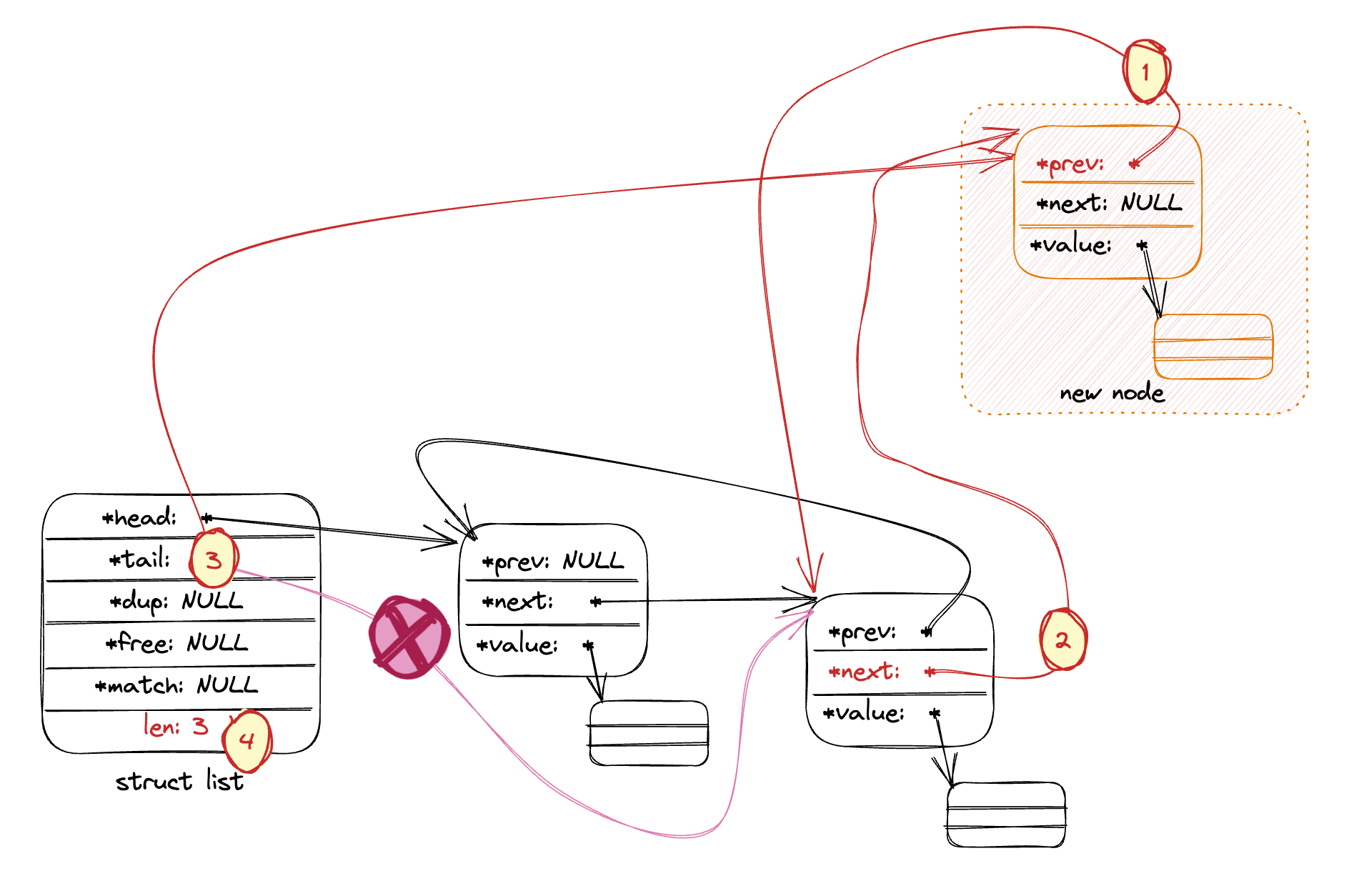
/* Add a new node to the list, to tail, containing the specified 'value'
* pointer as value.
*
* On error, NULL is returned and no operation is performed (i.e. the
* list remains unaltered).
* On success the 'list' pointer you pass to the function is returned. */
list *listAddNodeTail(list *list, void *value)
{
listNode *node;
if ((node = zmalloc(sizeof(*node))) == NULL)
return NULL;
node->value = value;
listLinkNodeTail(list, node);
return list;
}
/*
* Add a node that has already been allocated to the tail of list
*/
void listLinkNodeTail(list *list, listNode *node) {
if (list->len == 0) {
list->head = list->tail = node;
node->prev = node->next = NULL;
} else {
node->prev = list->tail;
node->next = NULL;
list->tail->next = node;
list->tail = node;
}
list->len++;
}
- 在链表指定位置插入
value:listInsertNode。如果after为非零, 则将新节点作为old_node后继节点。否则,新节点作为old_node前驱节点。下图以after为非零作为例子, 描述了这部分的代码逻辑。
(1) 将新节点的prev指向old_node(新节点插入在old_node之后);
(2) 将新节点的next指向old_node的后继节点(old_node的后继节点将成为新节点的后继节点);
(3) 将old_node的next指向新节点;
(4) 将新节点的后继节点的prev指向新节点(old_node的原后继节点现在成为了新节点的后继节点) 。
(5) 链表总计数加一
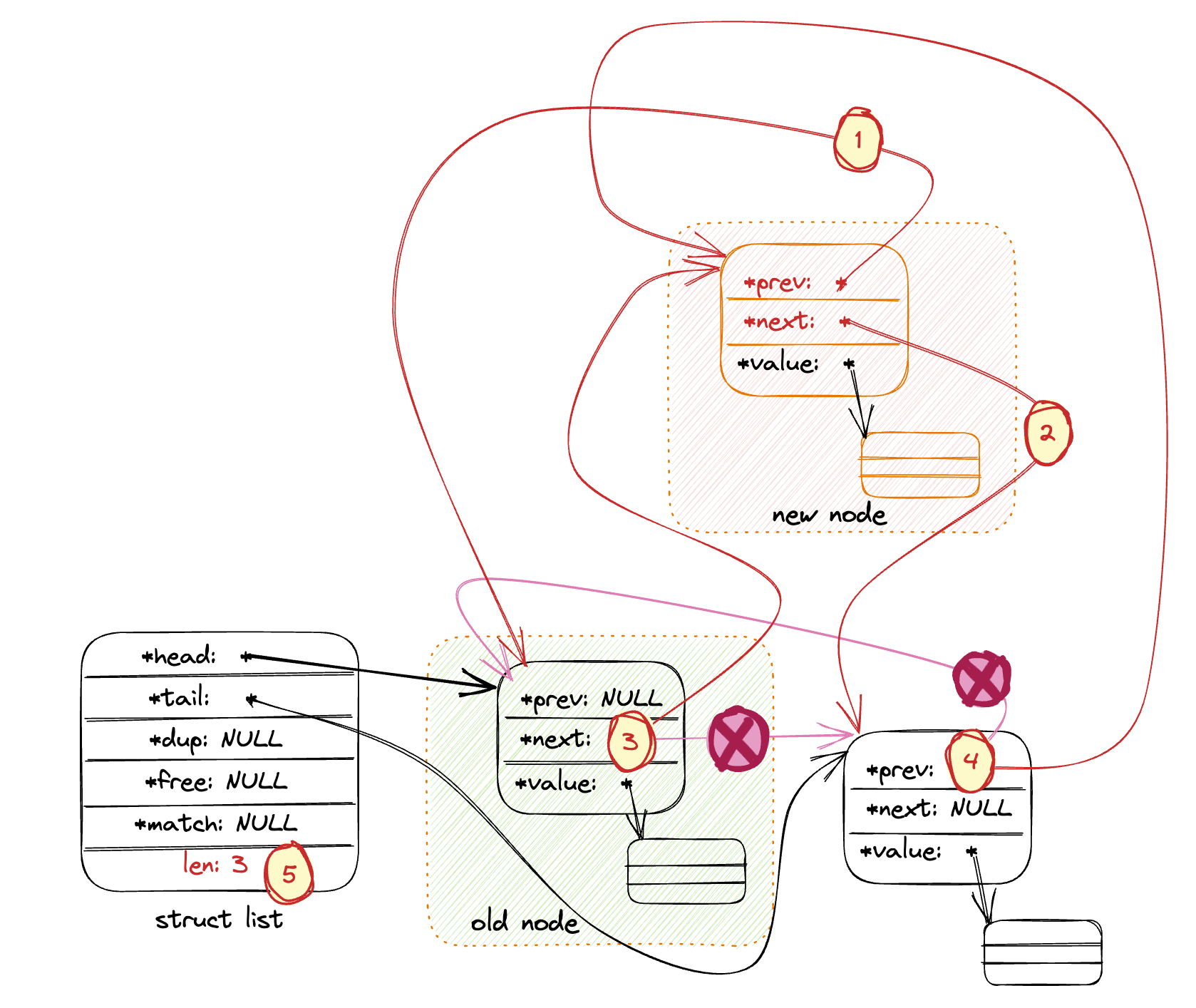
list *listInsertNode(list *list, listNode *old_node, void *value, int after) {
listNode *node;
if ((node = zmalloc(sizeof(*node))) == NULL)
return NULL;
node->value = value;
if (after) {
node->prev = old_node;
node->next = old_node->next;
if (list->tail == old_node) {
list->tail = node;
}
} else {
node->next = old_node;
node->prev = old_node->prev;
if (list->head == old_node) {
list->head = node;
}
}
if (node->prev != NULL) {
node->prev->next = node;
}
if (node->next != NULL) {
node->next->prev = node;
}
list->len++;
return list;
}
- 删除链表指定节点:
listDelNode。 下图以删除中间节点为例,展示了删除的流程。
(1) 待删除节点的前驱节点的next指向待删除节点的后继节点;
(2) 待删除节点的后继节点的prev指向待删除节点的前驱节点;
(3) 待删除节点的next和prev都置为NULL;
(4) 链表总计数减一
(5) 如果有注册free函数,则用free函数释放待删除节点的value。然后释放待删除节点。

/* Remove the specified node from the specified list.
* The node is freed. If free callback is provided the value is freed as well.
*
* This function can't fail. */
void listDelNode(list *list, listNode *node)
{
listUnlinkNode(list, node);
if (list->free) list->free(node->value);
zfree(node);
}
/*
* Remove the specified node from the list without freeing it.
*/
void listUnlinkNode(list *list, listNode *node) {
if (node->prev)
node->prev->next = node->next;
else
list->head = node->next;
if (node->next)
node->next->prev = node->prev;
else
list->tail = node->prev;
node->next = NULL;
node->prev = NULL;
list->len--;
}
5.链表的 Join 操作: listJoin 在链表l的末尾添加列表o的所有元素。 下图以两个链表都不为 NULL 的场景为例。
(1) o 的首部节点的 prev 指向 l 的尾部节点;
(2) l 的尾部节点的 next 指向 o 的首部节点(1,2 步将两个链表链接起来);
(3) l 的 tail 指向 o 的 tail(o 的 tail作为新链表的尾部);
(4) l 链表总计数加一;
(5) (6) 清空 o 链表的信息;
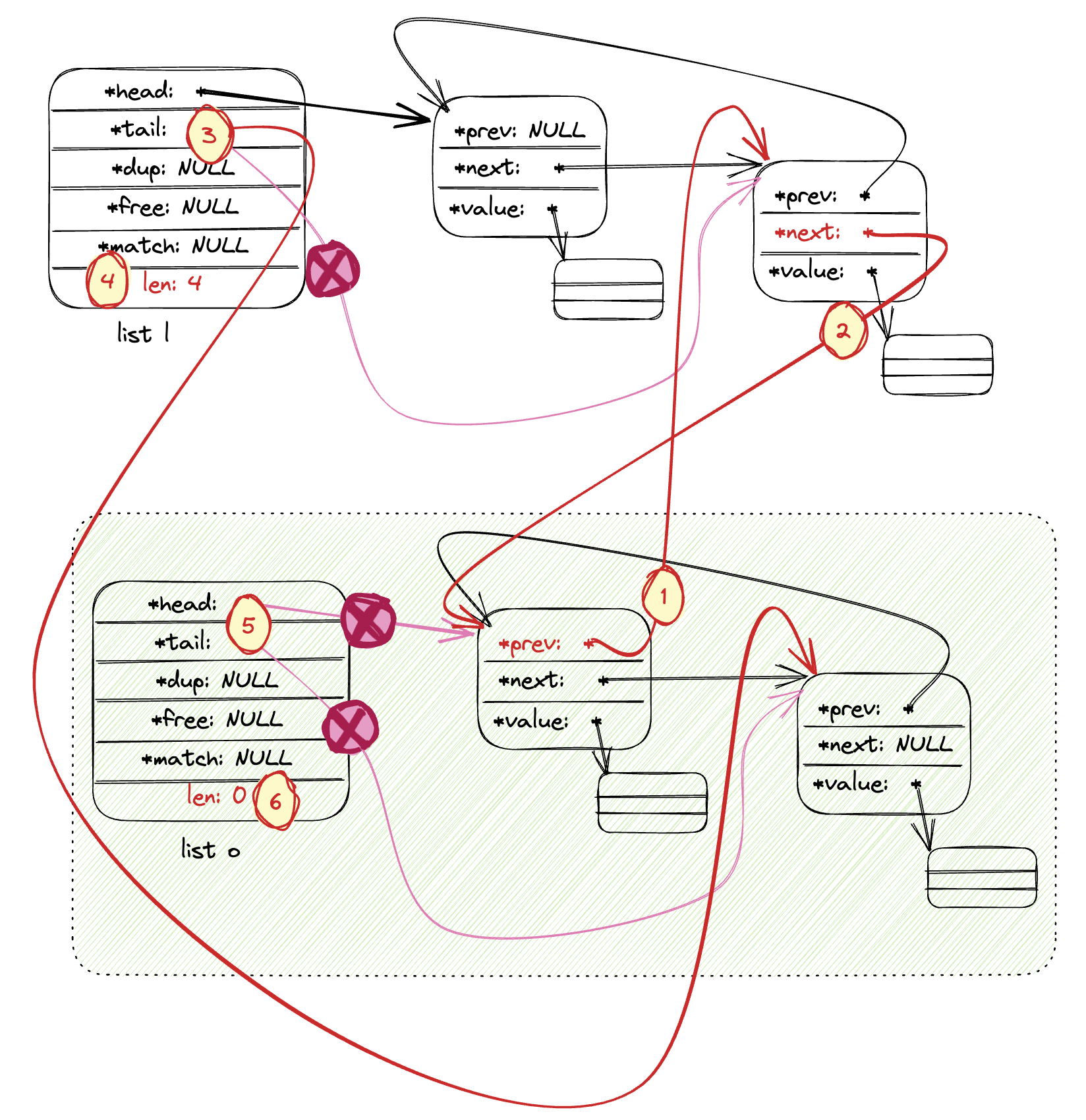
/* Add all the elements of the list 'o' at the end of the
* list 'l'. The list 'other' remains empty but otherwise valid. */
void listJoin(list *l, list *o) {
if (o->len == 0) return;
o->head->prev = l->tail;
if (l->tail)
l->tail->next = o->head;
else
l->head = o->head;
l->tail = o->tail;
l->len += o->len;
/* Setup other as an empty list. */
o->head = o->tail = NULL;
o->len = 0;
}
- 其他函数: 其他函数实现较为简单,这里简单罗列一下,感兴趣的可以去看下源码。
// 获取 list 的迭代器
listIter *listGetIterator(list *list, int direction);
// 返回迭代器的下一个元素,并将迭代器移动一位。如果已遍历完成, 则返回 NULL
listNode *listNext(listIter *iter);
// 释放迭代器资源
void listReleaseIterator(listIter *iter);
// 拷贝链表
list *listDup(list *orig);
// 在链表中查找与 key 匹配的 value 所在的第一个节点。
// 如果不存在,则返回 NULL。
// 匹配操作由 list->match 函数提供。
// 如果没有注册 match 函数, 则直接比较 key 是否与 value 相等。
listNode *listSearchKey(list *list, void *key);
// 返回指定的索引的元素。 如果超过了链表范围, 则返回 NULL。
// 正整数表示从首部开始计算。
// 0 表示第一个元素, 1 表示第二个元素, 以此类推。
// 负整数表示从尾部开始计算。
// -1 表示倒数第一个元素, -2 表示倒数第二个元素,以此类推。
listNode *listIndex(list *list, long index);
// 返回链表初始化的正向迭代器
void listRewind(list *list, listIter *li);
// 返回链表初始化的反向迭代器
void listRewindTail(list *list, listIter *li);
// 将链表尾部节点移到首部
void listRotateTailToHead(list *list);
// 将链表首部节点移到尾部
void listRotateHeadToTail(list *list);
// 用 value 初始化节点
void listInitNode(listNode *node, void *value);
adlist 的使用 demo
[email protected]:younglionwell/redis-adlist-example.git
关注公众号了解更多 redis 源码细节和其他技术内容。 你的关注是我最大的动力。

Recommend
About Joyk
Aggregate valuable and interesting links.
Joyk means Joy of geeK